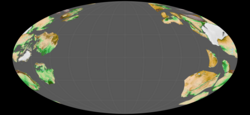Stenian
Topic: Earth
 From HandWiki - Reading time: 2 min
From HandWiki - Reading time: 2 min
Short description: Third and last period of the Mesoproterozoic Era
| Stenian | |
|---|---|
| 1200 – 1000 Ma | |
 Paleoglobe of Earth during the late Stenian, c. 1040 Ma | |
| Chronology | |
| Etymology | |
| Name formality | Formal |
| Usage information | |
| Celestial body | Earth |
| Regional usage | Global (ICS) |
| Time scale(s) used | ICS Time Scale |
| Definition | |
| Chronological unit | Period |
| Stratigraphic unit | System |
| Time span formality | Formal |
| Lower boundary definition | Defined chronometrically |
| Upper boundary definition | Defined chronometrically |
The Stenian Period (/ˈstiːni.ən/ STEE-nee-ən, from Ancient Greek:, meaning "narrow") is the final geologic period in the Mesoproterozoic Era and lasted from 1200 Mya to 1000 Mya (million years ago). Instead of being based on stratigraphy, these dates are defined chronometrically. The name derives from narrow polymetamorphic belts formed over this period.
Preceded by the Ectasian Period and followed by the Neoproterozoic Era.
The supercontinent Rodinia assembled during the Stenian. It would last into the Tonian Period.
This period includes the formation of the Keweenawan Rift at about 1100 Mya.[2]
Fossils of the oldest known sexually reproducing organism, Bangiomorpha pubescens, first appeared in the Stenian.[3]
See also
- Earth:Boring Billion – Earth history, 1.8 to 0.8 billion years ago
- Earth:Riphean (stage)
Notes
- ↑ 1.0 1.1 Plumb, K. A. (June 1, 1991). "New Precambrian time scale". Episodes 14 (2): 139–140. doi:10.18814/epiiugs/1991/v14i2/005.
- ↑ "Organic geochemical study of mineralization in the Keweenawan Nonesuch Formation at White Pine, Michigan". University of Michigan. http://deepblue.lib.umich.edu/bitstream/2027.42/28843/1/0000678.pdf.
- ↑ Gibson, Timothy M; Shih, Patrick M; Cumming, Vivien M; Fischer, Woodward W; Crockford, Peter W; Hodgskiss, Malcolm S.W; Wörndle, Sarah; Creaser, Robert A et al. (2017). "Precise age of Bangiomorpha pubescens dates the origin of eukaryotic photosynthesis". Geology 46 (2): 135–138. doi:10.1130/G39829.1. https://authors.library.caltech.edu/83811/3/2018030.pdf.
References
- "Stenian Period". GeoWhen Database. http://www.stratigraphy.org/geowhen/stages/Stenian.html.
- James G. Ogg (2004). "Status on Divisions of the International Geologic Time Scale". Lethaia 37 (2): 183–199. doi:10.1080/00241160410006492.
 |
Licensed under CC BY-SA 3.0 | Source: https://handwiki.org/wiki/Earth:Stenian8 views | Status: cached on August 08 2024 04:54:53↧ Download this article as ZWI file
 KSF
KSF